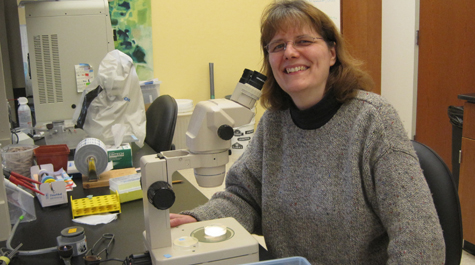Researchers document the biology behind a sex oddity
A paper published in the prestigious online journal Nature Communications reveals the molecular biology behind a certain worm’s ability to break—or at least ignore—the laws of Mendelian genetics.
The title of the paper is “Asymmetric spermatocyte division as a mechanism for controlling sex ratios.” It’s an important set of findings, with practical implications for ecology, genetics, parasitology and other fields. William & Mary Associate Professor of Biology Diane Shakes, the lead author on the paper, has already done interviews with the BBC and the British national daily The Guardian.
Rhabditis sp. SB347 is a species of nematode that produce only five percent male offspring. Shakes’ paper outlines the unusual developmental processes that lead to skewing of the worms’ sex ratio.
Mendel’s first law states that sexually reproducing organisms should produce equal numbers of males and females, Shakes notes, but Rhabditis and many other species of roundworms exhibit more complex reproductive strategies. For example, the other 95 percent of Rhabditis aren’t all females: “About 35 percent of this species are hermaphrodites,” Shakes said, “and they can be self-fertilizing.” Some other species of nematodes, she said, produce some offspring that are parthenogenic—females that are self-replicating.
The kaleidosexual reproductive tactics of Rhabditis and other nematodes pose a number of interesting scientific questions, from the evolutionary implications down to the cellular level. Shakes was able to detail some of the cellular processes that result in the disproportionately small number of male Rhabditis offspring by comparing the cellular process of sperm production in males of Rhabditis with the well-documented process in the “model nematode” Caenorhabditis elegans.
In their paper, Shakes and her collaborators reported on unusual development during spermatogenesis in the worms. Spermatogenesis builds sperm cells through meiosis, a form of cell division in which an individual’s chromosomes are copied and then proceed through two rounds of division in preparation for reproduction. They found that in a large percentage of Rhabditis males, unusual asymmetric protein formations during a critical stage of meiosis lead to a unusual distribution of sex chromosomes.
The cellular asymmetry results in a situation in which the necessarily proteins for a sperm cell to be active are delivered to cells bearing the genetic selector for female offspring—the X chromosome. Corresponding cells that would produce male offspring miss out, she said.
During the typical process of sperm production, the early-stage sperm cells (spermatocytes) divide twice to generate four sperm, Shakes explained. Two of the four have the capacity to fertilize eggs and generate daughters. The other two—which don’t contain the X chromosome—have the capacity to generate sons. In almost all animals, all four sperm have an equal chance of fertilizing an egg. But the cellular asymmetry of Rhabditis loads the dice for daughters, she said.
“In this species, the X-bearing sperm receives all of the proteins that sperm need to be viable while the other sperm are ‘duds’, Shakes explained. “The cells that would produce sons fail to receive the ‘goods.’ So, they can't move, they can't fertilize an egg, and are presumably discarded. These males produce only daughters, because the sperm that could have contributed to the production of sons is no good.”
The unusual reproductive strategy presents a set of adaptive advantages for Rhabditis, Shakes said.
“This species has three sexes—males, females and hermaphrodites,” she explained. “The hermaphrodites are little different behaviorally. They go through a dispersive stage where they go out and explore new territories. If they go exploring and find a new food source, hermaphrodites can start a new population all by themselves.”
In addition, Rhabditis is related to a number of parasitic nematodes that produce hermaphrodites or parthenogenic females, “and those are the ones that actually go out and infect the host,” she said. Shakes noted that additional laboratory study of Rhabditis could yield insight on new options for parasite control.
Nature Communications is a new on-line offering from the publishers of Nature, the preeminent journal in the life sciences. Shakes’ collaborators include Jyotiska Chaudhuri and Andre Pires-daSilva, both of the University of Texas at Arlington, as well as a former William & Mary undergraduate, Bryan J. Neva ’10, now in graduate school at the University of Michigan.
 Skip to main content
Skip to main content

